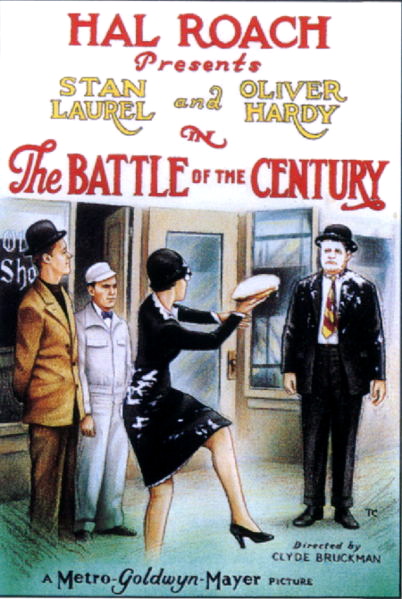“You can’t throw pies in comedies anymore!”
Laurel and Hardy’s “The Battle of the Century” didn’t immediately rehabilitate the pie fight in Hollywood at the end of 1927. But here are three data points that show the trope moving back to acceptance, if never full respectability.
This movie survives in a German print, in loose footage, and in the Weiss Brothers Collection at UCLA. I’m guessing at the date based on the apparent age of Bobby Nelson, between his waifish appearances in “The Doughboy” (1926), “Sunshine of Paradise Alley” (1926), and “Perils of the Jungle“ (1927) and his post-haircut westerns.
The only title I’ve found linked to this footage is “Bobby’s Pie Fight”—“Bobby’s Kuchenschlacht” in Germany and “Il combattimento di Bobby” in Italy. However, that title might have been attached when the Weiss brothers recut their 1920s films for television syndication in the series Chuckle Heads.
Unfortunately, the Weiss brothers were near the bottom of the barrel among Hollywood producers. They saved money by skipping such steps as registering copyrights and screening movies for critics. As a result, scholars can’t even say when most of their movies were released. “Bobby’s Pie Fight” has no IMDB listing, so I can’t confirm its original title or date.
Assuming that “Bobby’s Pie Fight” was the title, that shows Artclass believed that subject would attract rather than turn off its target audience. At the same time, the company made sure the pie wagon was crudely labeled “Hokum Pie Co.” to signal to adults that they knew they were slinging an old joke. This pie fight was just for the kids.
Next comes the Our Gang comedy “Shivering Shakespeare,” directed by Anthony Mack in 1929 and released in January 1930 (IMDB; YouTube; Lucky Corner; Lord Heath).
Like several other early talking pictures in the series, this was a remix of silent films from a few years before. As in “Stage Fright” (1923), it showed the gang being dragooned into putting on a play set during Nero’s reign. As in “Uncle Tom’s Uncle” (1926), the kids in the audience pelt the kids on the stage with food.
“Uncle Tom’s Uncle” (and its direct remake, “Spanky” [1932]) showed the audience throwing vegetables. For “Shivering Shakespeare,” in contrast, the theatergoers are supplied with two booths full of pies, apparently from a fundraising bake sale. Furthermore, that audience includes both kids (rowdies led by Jack McHugh) and dignified-looking adults.
The result is a pie fight much like “The Battle of the Century”—the first in a talking picture, some scholars posit. As in that earlier Roach studio film, there’s a gradual build-up of pie-throwing, trying to make the action meaningful instead of just messy. Mack filmed some of that action in slow motion, leaving those shots with no sound. The result isn’t entirely satisfactory, but five years earlier no respected studio would have even tried such hokum.
Finally, in 1931 Educational Films released “The Lure of Hollywood,” part of the Hollywood Girls series (IMDB; YouTube). These were definitely movies about and for adults, not children.
In “The Lure of Hollywood” a mix-up leads a young studio props man to think that a movie star is hitting on his hopeful-starlet girlfriend. During the filming of a big musical number on the theme of custard pies, therefore, the props man throws a pie at the movie star. That devolves into a pie fight, the two cameras still rolling.
A studio executive bustles onto the set and shouts: “You can’t throw pies in comedies anymore! The public won’t laugh at it.” That was, of course, the standard wisdom of movie makers and critics for a decade from the late 1910s to the late 1920s.
The film’s heroines leave Los Angeles in a cheap used car, their Hollywood dreams in ruins. But then the studio staff views the rushes from that supposedly ruined scene. The screening room erupts in laughter. The same executive says: “That’s the funniest thing we’ve ever photographed. We should have gone in for that pie-throwing long ago!”
Pie-throwing thus appears restored to its status as a Hollywood gag—a classic gag, in fact. Being able to depict that turnaround was undoubtedly gratifying for the director of “The Lure of Hollywood”: credited as William Goodrich, that was actually the Keystone veteran Roscoe “Fatty” Arbuckle.








